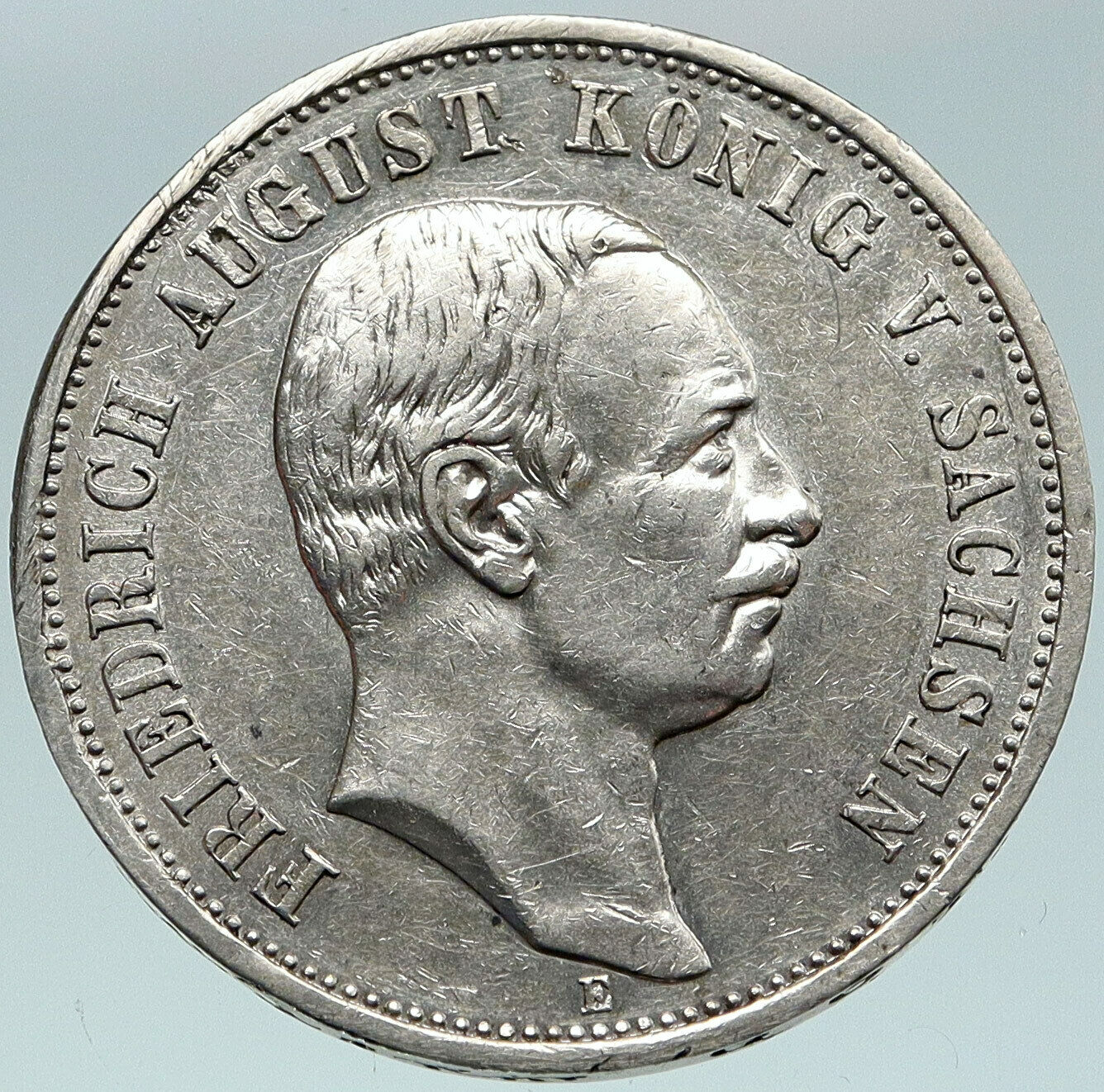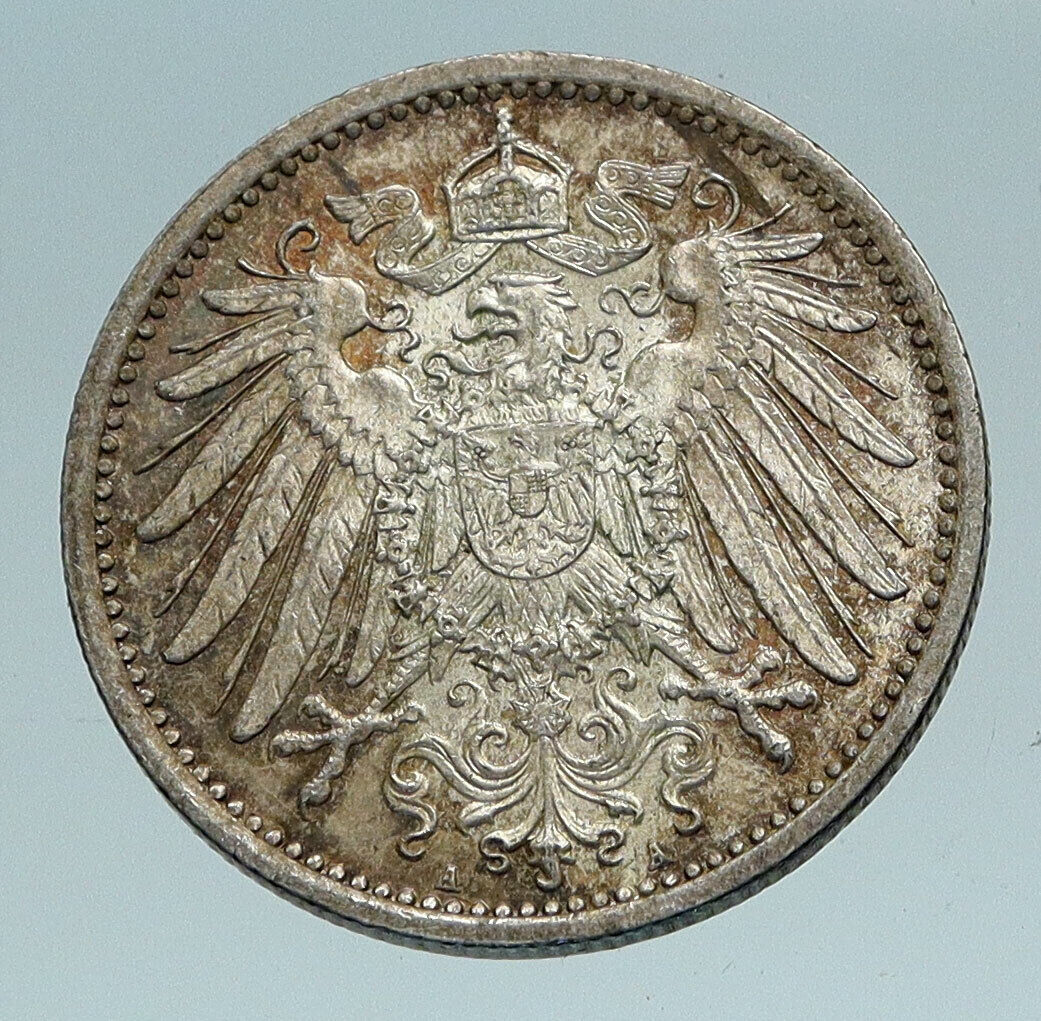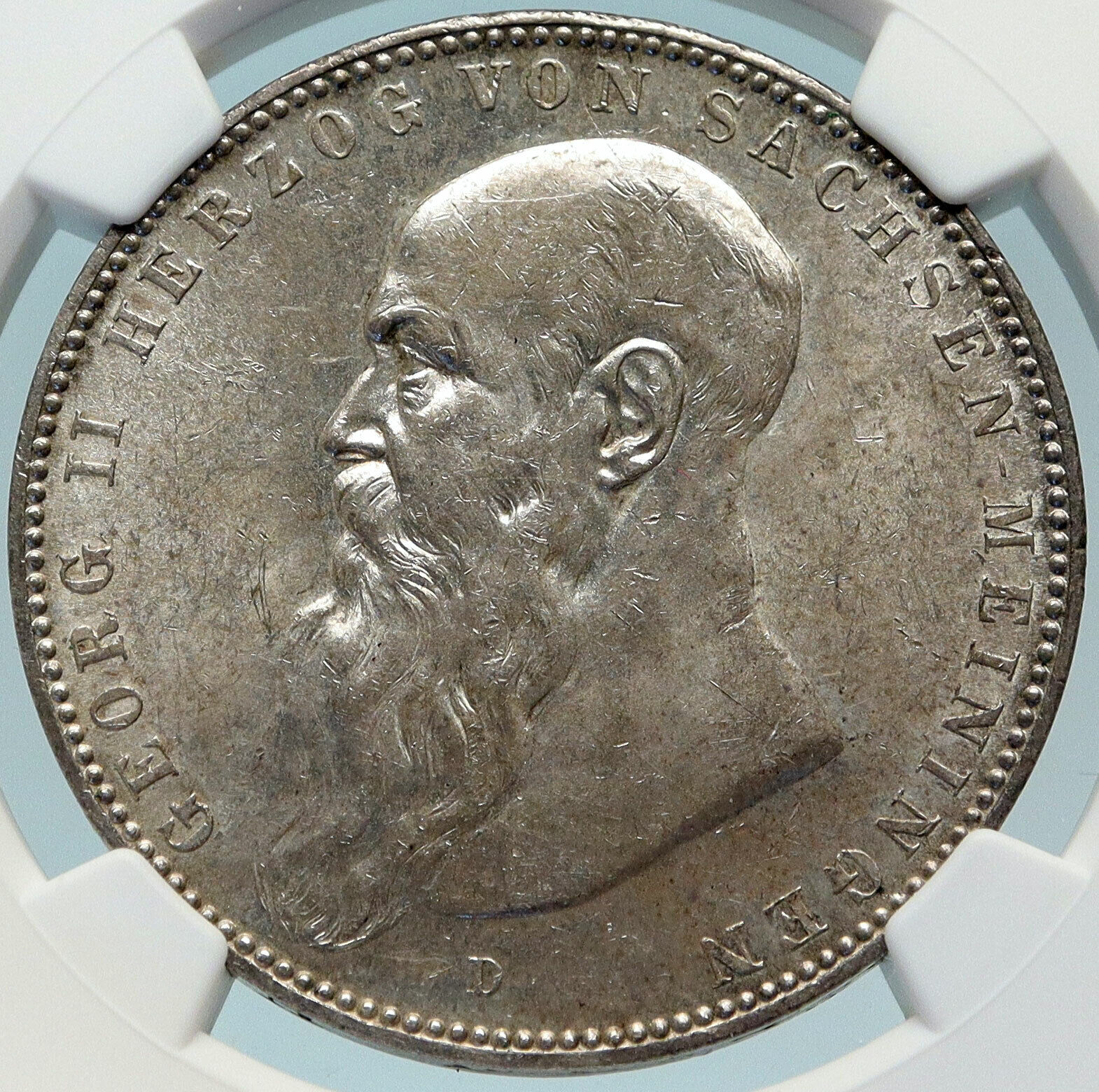|
German States – Saxony – Ruled by Friedrich August III
National Battle Monument at Leipzig 100th Anniversary Dedication
1913 E Proof-like Silver 3 Mark Coin 33mm (16.68 grams) .900 Silver (0.4823 oz ASW)
Reference: KM# 1275
18. OKTOBER *1813 = 1913* E, Monument divides date above.
DEUTSCHES REICH 1913 * DREI MARK *, Crowned imperial eagle with shield on breast.
Edge Lettering:
G O T T *~:~+~:~* M I T *~:~+~:~* U N S *~:~+~:~*
You are bidding on the exact item pictured, provided with a Certificate of Authenticity and Lifetime Guarantee of Authenticity.
 The Monument to the Battle of the Nations (German: Völkerschlachtdenkmal, sometimes shortened to Völki) is a monument in Leipzig , Germany , to the 1813 Battle of Leipzig , also known as the Battle of the Nations . Paid for mostly by donations and by the city of Leipzig, it was completed in 1913 for the 100th anniversary of the battle, at a cost of 6 million Goldmark . The Monument to the Battle of the Nations (German: Völkerschlachtdenkmal, sometimes shortened to Völki) is a monument in Leipzig , Germany , to the 1813 Battle of Leipzig , also known as the Battle of the Nations . Paid for mostly by donations and by the city of Leipzig, it was completed in 1913 for the 100th anniversary of the battle, at a cost of 6 million Goldmark .
The monument commemorates Napoleon’s defeat at Leipzig, a crucial step towards the end of hostilities in the War of the Sixth Coalition , which was seen[by whom?] as a victory for the German people, although Germany as we know it did not begin to exist until 1870. There were German speakers fighting on both sides, as Napoleon ‘s troops also included conscripted Germans from the French-occupied left bank of the Rhine as well as from the Confederation of the Rhine .
The structure is 91 metres (299 ft) tall. It contains over 500 steps to a viewing platform at the top, from which there are spectacular views across the city and environs. The structure makes extensive use of concrete , although the facings are of granite . The monument is widely regarded as one of the best examples of Wilhelmine architecture. It is said to stand on the spot of some of the bloodiest fighting, from where Napoleon ordered the retreat of his army. Between 16-19 October 1813, the Battle of the Nations was fought by the coalition armies of Russia, Prussia, Austria, and Sweden against the French army of Napoleon aided by Polish and Italian troops as well as German-speakers from the Confederation of the Rhine. Napoleon’s army was defeated and compelled to return to France while the Allies invaded France early the next year. Napoleon was forced to abdicate and was exiled to Elba in May 1814.
In 1814 proposals to build a monument to commemorate the battle were made. Among the supporters of the project, author Ernst Moritz Arndt called for the construction of a “a large and magnificent (monument), like a colossus, a pyramid, or the cathedral of Cologne “. Architect Friedrich Weinbrenner created a design for the monument that ultimately was not used.
In 1863, commemorating the 50th anniversary of the battle, a foundation stone was placed, but the memorial was not built. Clemens Thieme, a member of the Verein für die Geschichte Leipzigs (Association for the History of Leipzig) learned during a meeting of the association about the past plans to build a monument. Interested in resuming the project, Thieme, who was also a member of the Apollo masonic lodge , proposed the project during a meeting and gained the support of his fellow masons. In 1894, he founded the Deutsche Patriotenbund (Association of German Patriots) which raised, by means of donations and a lottery, the funds necessary to construct the monument for the 100th anniversary . The following year, the city of Leipzig donated a 40,000-square-metre (9.9-acre) site for the construction. The project was commissioned to Bruno Schmitz , due to his previous works at the Kyffhäuser . The construction began in 1898. The chosen construction site was the spot where Napoleon ordered the retreat of his army. Thieme financed part of the construction as well, and for his complete dedication to the project, he was named an Honorary Citizen of Leipzig.
In 1898, the construction started. 82,000 cubic metres (107,000 cu yd) of earth was moved; 26,500 granite blocks were used and the project resulted in a total cost of 6,000,000 (54,759,977€ in 2014), the monument was finished in 1913.
The Free State of Saxony (German: Freistaat Sachsen [ˈfʁaɪ̯ʃtaːt ˈzaksən] ; Upper Sorbian : Swobodny stat Sakska; Polish : Saksonia; Czech : Sasko) is a landlocked federal state of Germany , bordering the federal states of Brandenburg , Saxony Anhalt , Thuringia , and Bavaria , as well as the countries Poland and the Czech Republic . Its capital is Dresden .
It is the tenth-largest of Germany’s sixteen states in area, with an area of 18,413 square kilometres (7,109 sq mi), and, with a population of 4.3 million, the sixth most populous German state.
Located in the middle of a former German-speaking part of Europe, the history of the state of Saxony spans more than a millennium. It has been a medieval duchy , an electorate of the Holy Roman Empire , a kingdom , and twice a republic.
The area of the modern state of Saxony should not be confused with Old Saxony , the area inhabited by Saxons . Old Saxony corresponds approximately to the modern German states of Lower Saxony , Saxony-Anhalt and the Westphalian part of North Rhine-Westphalia .
 Frederick Augustus III (German: Friedrich August III.; 25 May 1865 in Dresden – 18 February 1932 in Sibyllenort) was the last King of Saxony (1904-1918) and a member of the House of Wettin. Frederick Augustus III (German: Friedrich August III.; 25 May 1865 in Dresden – 18 February 1932 in Sibyllenort) was the last King of Saxony (1904-1918) and a member of the House of Wettin.
Born in Dresden, Frederick Augustus was the first son of King George and his wife, Maria Anna of Portugal.
Frederick Augustus served in the Royal Saxon Army before becoming king, and later was promoted to Generalfeldmarschall. Though well-loved by his subjects, he voluntarily abdicated as king on 13 November 1918, after the defeat of the German Empire in World War I. He died in Sibyllenort (now Szczodre) in Lower Silesia and was buried in Dresden.
Military career
Frederick Augustus entered the Royal Saxon Army in 1877 as a second lieutenant, despite being only twelve years old. Given his royal status, he advanced rapidly through the ranks. He served initially with the Royal Saxon 1. (Leib-) Grenadier Regiment Nr. 100. He was promoted to first lieutenant in 1883, captain in 1887, major in 1889 and lieutenant colonel in 1891. By 1891, he was commander of the 1st Battalion of Schützen (Füsilier)-Regiment Nr. 108. He was promoted to colonel on 22 September 1892 and took command of the Schützen (Füsilier)-Regiment Nr. 108 on the same day. On 20 September 1894, the 29-year-old prince was promoted to Generalmajor and given command of the 1st Royal Saxon Infantry Brigade Nr. 45 (Saxon higher units usually bore two numbers: one their Saxon Army number and the other their number in the Prussian Army order of battle). On 22 May 1898, he was promoted to Generalleutnant and given command of the 1st Royal Saxon Infantry Division Nr. 23. He commanded this division until 26 August 1902, when he took command of the XII (1st Royal Saxon) Corps. He was promoted to General der Infanterie one month later, on 24 September. He remained in command of the corps until October 1904, when he became king. His military career effectively ended with his accession to the throne, but he was promoted subsequently to Generaloberst and then to Generalfeldmarschall (on 9 September 1912).
Following his father’s accession, he was in July 1902 appointed à la suite of the German Marine Infantry by Emperor Wilhelm II during a visit to Kiel.
Family
Frederick Augustus married Archduchess Luise, Princess of Tuscany, in Vienna on 21 November 1891. They were divorced in 1903 by the royal decree of the King after she ran away while pregnant with her last child. Luise’s flight from Dresden was due to her father-in-law’s threatening to have her interned in Sonnestein Mental Asylum for life. Her brother supported her in her wish to escape Saxony. Emperor Franz-Josef of Austria-Hungary did not recognise the divorce.
Their two eldest sons, Friedrich August and Friedrich Christian were born in the same year, 1893, but were not twins. Friedrich August was born in January, while Friedrich Christian was born in December.
Quotes
- When standing in uniform on a station platform, a lady asked him to move her trunk. He is reported to have replied, “Madam, I am not a porter; I only look like one.”
- When the German Republic was proclaimed in 1918, he was asked by telephone whether he would abdicate willingly. He said: “Oh, well, I suppose I’d better.”
- Upon abdicating, he is supposed to have said “Nu da machd doch eiern Drägg alleene!” (Saxon for “Well then, do your shit by yourselves!” or more accurately, “Well then take care of this crap yourselves!”), but there is no documentation of this.
- When cheered by a crowd in a railroad station several years after his abdication, he stuck his head out of the train’s window and shouted “Ihr seid mer ja scheene Demogradn!” (Saxon for “You’re a fine lot of republicans, I’ll say!”).
 Germany, officially the Federal Republic of Germany is a federal parliamentary republic in western-central Europe. It includes 16 constituent states and covers an area of 357,021 square kilometres (137,847 sq mi) with a largely temperate seasonal climate. Its capital and largest city is Berlin. With 81 million inhabitants, Germany is the most populous member state in the European Union. After the United States, it is the second most popular migration destination in the world. Germany, officially the Federal Republic of Germany is a federal parliamentary republic in western-central Europe. It includes 16 constituent states and covers an area of 357,021 square kilometres (137,847 sq mi) with a largely temperate seasonal climate. Its capital and largest city is Berlin. With 81 million inhabitants, Germany is the most populous member state in the European Union. After the United States, it is the second most popular migration destination in the world.
Various Germanic tribes have occupied northern Germany since classical antiquity. A region named Germania was documented before 100 CE. During the Migration Period the Germanic tribes expanded southward. Beginning in the 10th century, German territories formed a central part of the Holy Roman Empire. During the 16th century, northern German regions became the centre of the Protestant Reformation.
The rise of Pan-Germanism inside the German Confederation resulted in the unification of most of the German states in 1871 into the Prussian-dominated German Empire. After World War I and the German Revolution of 1918-1919, the Empire was replaced by the parliamentary Weimar Republic. The establishment of the Third Reich in 1933 led to World War II and the Holocaust. After 1945, Germany split into two states, East Germany and West Germany. In 1990, the country was reunified.
 In the 21st century, Germany is a great power and has the world’s fourth-largest economy by nominal GDP, as well as the fifth-largest by PPP. As a global leader in several industrial and technological sectors, it is both the world’s third-largest exporter and importer of goods. Germany is a developed country with a very high standard of living sustained by a skilled and productive society. It upholds a social security and universal health care system, environmental protection and a tuition free university education. In the 21st century, Germany is a great power and has the world’s fourth-largest economy by nominal GDP, as well as the fifth-largest by PPP. As a global leader in several industrial and technological sectors, it is both the world’s third-largest exporter and importer of goods. Germany is a developed country with a very high standard of living sustained by a skilled and productive society. It upholds a social security and universal health care system, environmental protection and a tuition free university education.
Germany was a founding member of the European Union in 1993. It is part of the Schengen Area, and became a co-founder of the Eurozone in 1999. Germany is a member of the United Nations, NATO, the G8, the G20, and the OECD. The national military expenditure is the 9th highest in the world. Known for its rich cultural history, Germany has been continuously the home of influential artists, philosophers, musicians, sportsmen, entrepreneurs, scientists and inventors.
|





 The Monument to the Battle of the Nations (German: Völkerschlachtdenkmal, sometimes shortened to Völki) is a monument in Leipzig , Germany , to the 1813 Battle of Leipzig , also known as the Battle of the Nations . Paid for mostly by donations and by the city of Leipzig, it was completed in 1913 for the 100th anniversary of the battle, at a cost of 6 million Goldmark .
The Monument to the Battle of the Nations (German: Völkerschlachtdenkmal, sometimes shortened to Völki) is a monument in Leipzig , Germany , to the 1813 Battle of Leipzig , also known as the Battle of the Nations . Paid for mostly by donations and by the city of Leipzig, it was completed in 1913 for the 100th anniversary of the battle, at a cost of 6 million Goldmark .
 Frederick Augustus III (German: Friedrich August III.; 25 May 1865 in Dresden – 18 February 1932 in Sibyllenort) was the last King of Saxony (1904-1918) and a member of the House of Wettin.
Frederick Augustus III (German: Friedrich August III.; 25 May 1865 in Dresden – 18 February 1932 in Sibyllenort) was the last King of Saxony (1904-1918) and a member of the House of Wettin.  Germany, officially the Federal Republic of Germany is a federal parliamentary republic in western-central Europe. It includes 16 constituent states and covers an area of 357,021 square kilometres (137,847 sq mi) with a largely temperate seasonal climate. Its capital and largest city is Berlin. With 81 million inhabitants, Germany is the most populous member state in the European Union. After the United States, it is the second most popular migration destination in the world.
Germany, officially the Federal Republic of Germany is a federal parliamentary republic in western-central Europe. It includes 16 constituent states and covers an area of 357,021 square kilometres (137,847 sq mi) with a largely temperate seasonal climate. Its capital and largest city is Berlin. With 81 million inhabitants, Germany is the most populous member state in the European Union. After the United States, it is the second most popular migration destination in the world. In the 21st century, Germany is a great power and has the world’s fourth-largest economy by nominal GDP, as well as the fifth-largest by PPP. As a global leader in several industrial and technological sectors, it is both the world’s third-largest exporter and importer of goods. Germany is a developed country with a very high standard of living sustained by a skilled and productive society. It upholds a social security and universal health care system, environmental protection and a tuition free university education.
In the 21st century, Germany is a great power and has the world’s fourth-largest economy by nominal GDP, as well as the fifth-largest by PPP. As a global leader in several industrial and technological sectors, it is both the world’s third-largest exporter and importer of goods. Germany is a developed country with a very high standard of living sustained by a skilled and productive society. It upholds a social security and universal health care system, environmental protection and a tuition free university education.




